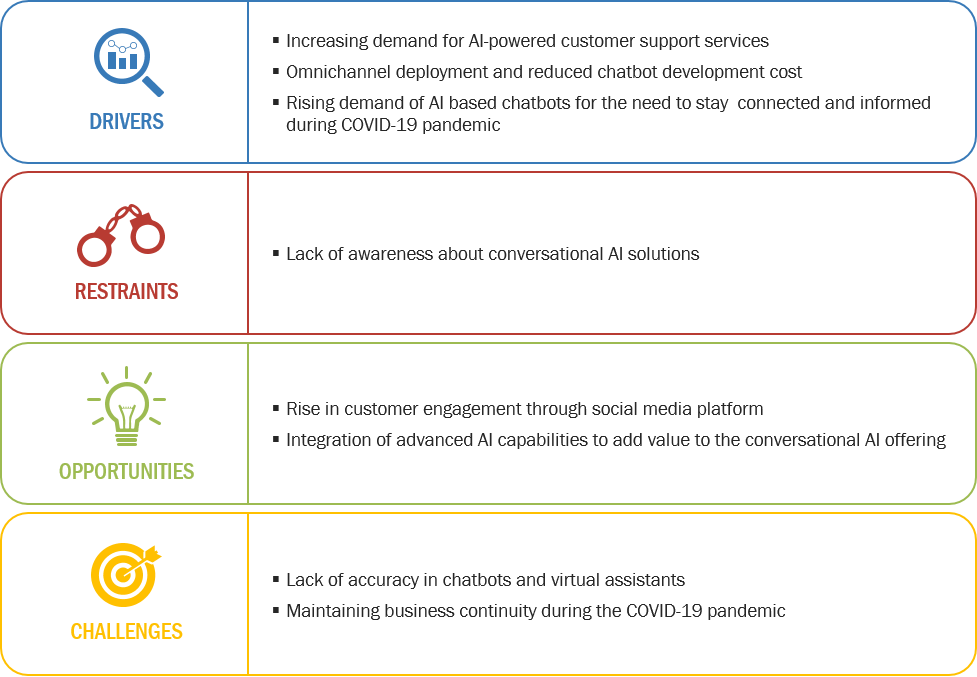Conversational AI Software Quadrant Report

Table of Contents
1 Introduction
1.1 Market Definition
2 Market Overview and Industry Trends
2.1 Introduction
2.2 Market Dynamics
Figure 1 Drivers, Restraints, Opportunities, and Challenges: Conversational AI Market
2.2.1 Drivers
2.2.1.1 Increasing Demand for AI-Powered Customer Support Services
2.2.1.2 Omnichannel Deployment and Reduced Chatbot Development Cost
2.2.1.3 Rising Demand for AI-Based Chatbots to Stay Connected and Informed During the Covid-19 Pandemic
2.2.2 Restraints
2.2.2.1 Lack of Awareness About Conversational AI Solutions
2.2.3 Opportunities
2.2.3.1 Rise in Customer Engagement Through Social Media Platforms
2.2.3.2 Integration of Advanced AI Capabilities to Add Value to Existing Conversational AI Offerings
2.2.4 Challenges
2.2.4.1 Lack of Accuracy in Chatbots and Virtual Assistants
2.2.4.2 Maintaining Business Continuity During the Covid-19 Pandemic
2.3 Cumulative Growth Analysis
2.4 Market Ranking Analysis, By Company
Figure 2 Key Players of the Conversational AI Market, 2018
2.5 Use Cases
2.5.1 Use Case: Scenario 1
2.5.2 Use Case: Scenario 2
2.5.3 Use Case: Scenario 3
2.5.4 Use Case: Scenario 4
2.5.5 Use Case: Scenario 5
2.6 Regulatory Implications
2.6.1 Introduction
2.6.2 General Data Protection Regulation
2.6.3 Health Insurance Portability and Accountability Act
2.6.4 Payment Card Industry Data Security Standard
2.6.5 Financial Industry Regulatory Authority
2.6.6 Service Organizational Control 2
2.6.7 Markets in Financial Instruments Directive II
2.7 Conversational AI, Architecture
Figure 3 Conversational AI, High Level Architecture Overview
3 Conversational AI Market: Covid-19 Impact
Figure 4 Conversational AI Market to Witness a Minor Decline Between 2020 and 2021
4 Company Evaluation Quadrant
4.1 Visionary Leaders
4.2 Innovators
4.3 Dynamic Differentiators
4.4 Emerging Companies
Figure 5 Global Conversational AI Market (Global), Company Evaluation Quadrant
4.5 Strength of Product Portfolio
Figure 6 Product Portfolio Analysis of Top Players in the Conversational AI Market
4.6 Business Strategy Excellence
Figure 7 Business Strategy Excellence of Top Players in the Conversational AI Market
5 Company Profiles
5.1 Google
5.1.1 Business Overview*
Figure 8 Google: Company Snapshot
5.1.2 Products Offered*
5.1.3 Recent Developments*
5.1.4 SWOT Analysis*
Figure 9 Google: SWOT Analysis
5.1.5 MnM View*
(*Above sections are present for all of below companies)
5.2 Microsoft
Figure 10 Microsoft: Company Snapshot
Figure 11 Microsoft: SWOT Analysis
5.3 AWS
Figure 12 AWS: Company Snapshot
Figure 13 AWS: SWOT Analysis
5.4 IBM
Figure 14 IBM: Company Snapshot
Figure 15 IBM: SWOT Analysis
5.5 Oracle
Figure 16 Oracle: Company Snapshot
Figure 17 Oracle: SWOT Analysis
5.6 Nuance
Figure 18 Nuance: Company Snapshot
5.7 Baidu
Figure 19 Baidu: Company Snapshot
5.8 SAP
Figure 20 SAP: Company Snapshot
5.9 Artificial Solutions
5.10 Kore.ai
5.11 Avaamo
5.12 Conversica
5.13 Haptik
5.14 Rasa
6 Appendix
6.1 Other Significant Players
6.1.1 Solvvy
6.1.2 Pypestream
6.1.3 Inbenta
6.1.4 Rulai
6.1.5 Creative Virtual
6.1.6 Saarthi.ai
6.1.7 FIS
6.1.8 AmplifyReach
6.1.9 Interactions
6.1.10 Quosphere
6.1.11 Exceed.ai
6.1.12 Cognigy.AI
6.1.13 SoundHound Inc.
6.1.14 Kasisto
6.1.15 Mindsay
6.1.16 Clinc
6.2 Methodology
This report identifies and benchmarks the best Conversational AI solution providers such as Microsoft (US), Google (US), AWS (US), Oracle (US), IBM (US), Baidu (China) and SAP (Germany), and evaluates them on the basis of business strategy excellence and strength of product portfolio within the Field Service Management ecosystem, combining inputs from various industry experts, buyers, and vendors, and extensive secondary research including annual reports, company press releases, investor presentations, free and paid company databases. They are rated and positioned on 2x2 matrix, called as ‘Company Evaluation Quadrant’, and identified as Visionary Leaders, Dynamic Differentiators, Innovators, or Emerging companies.
SAMPLES:
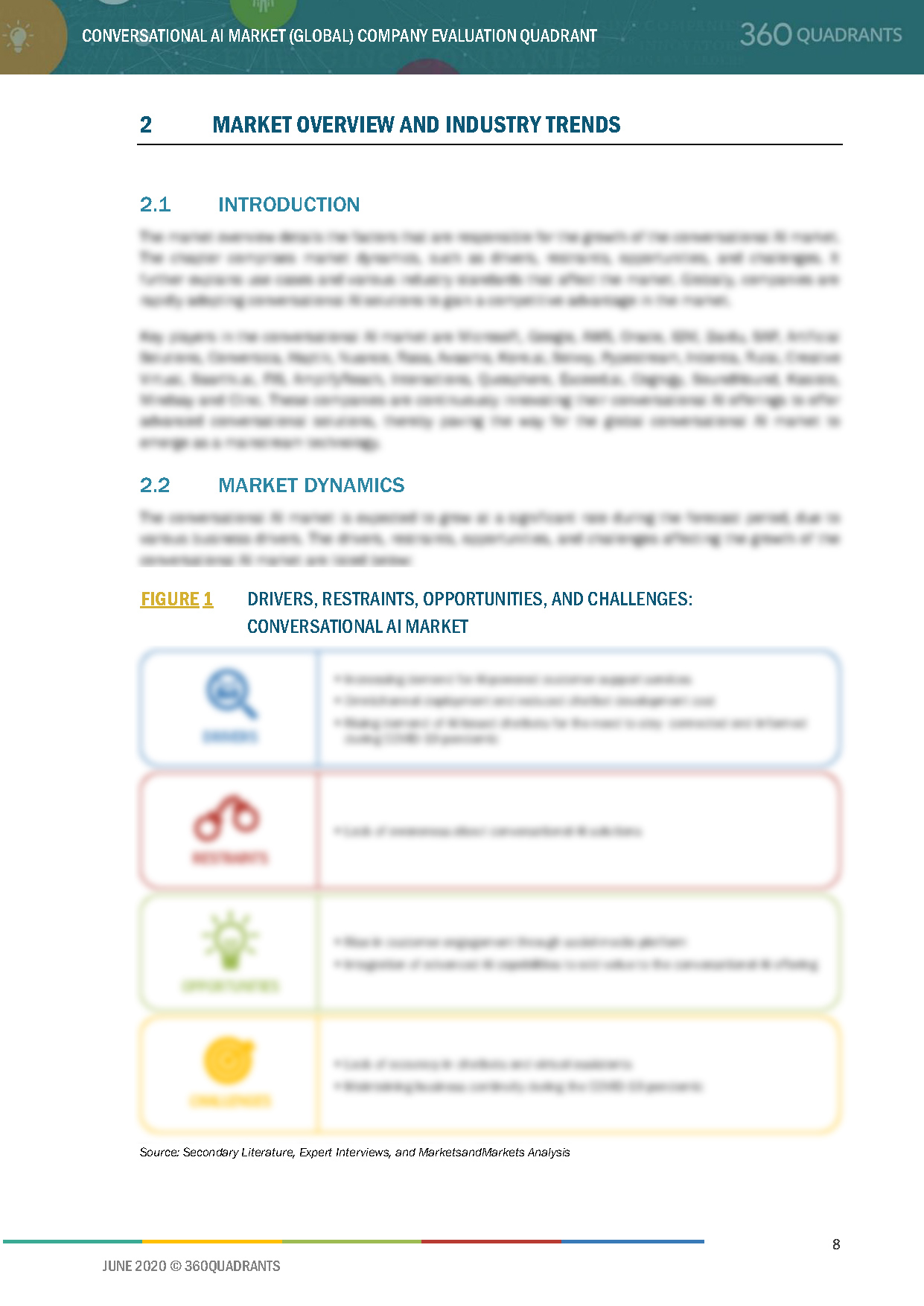
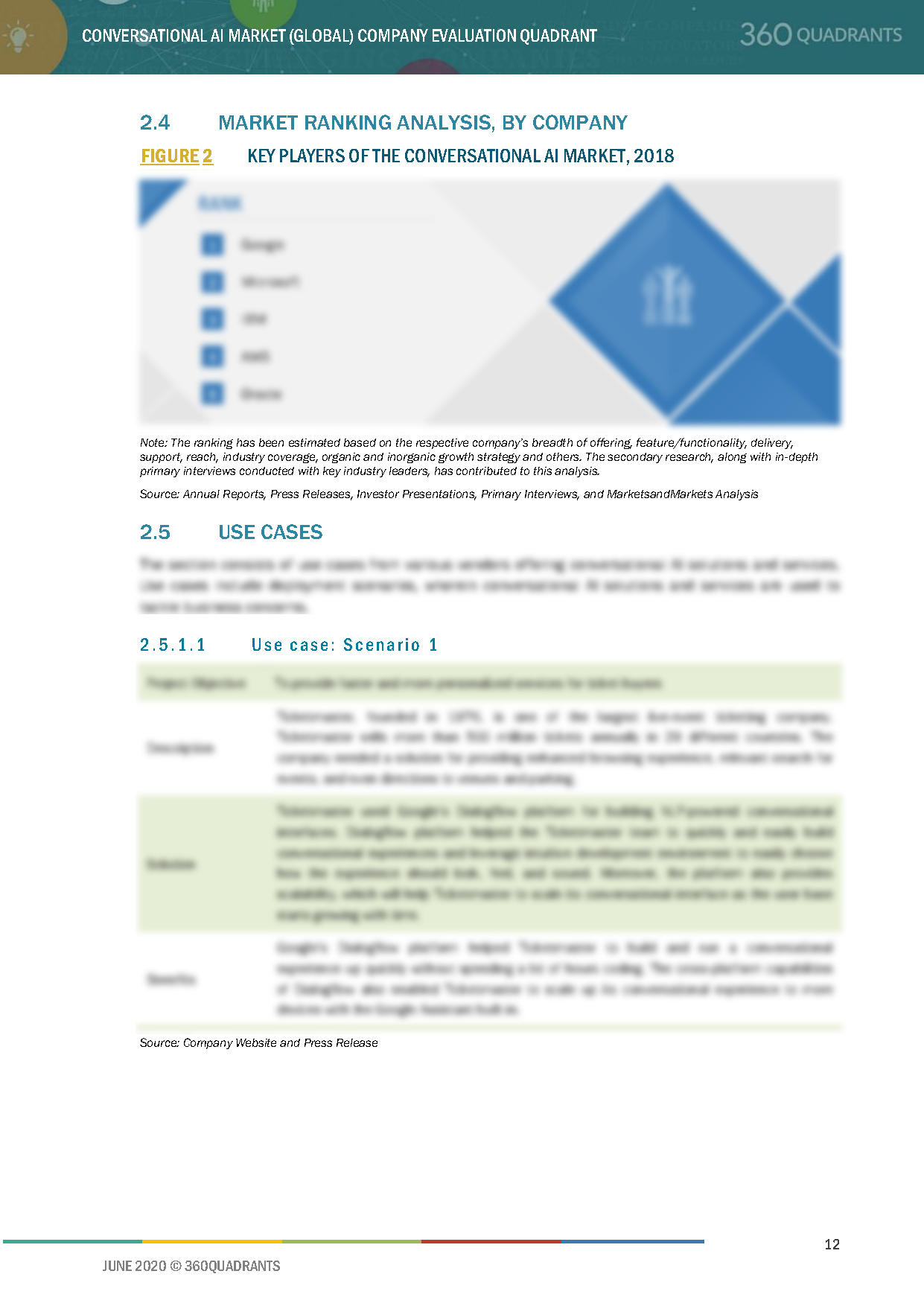
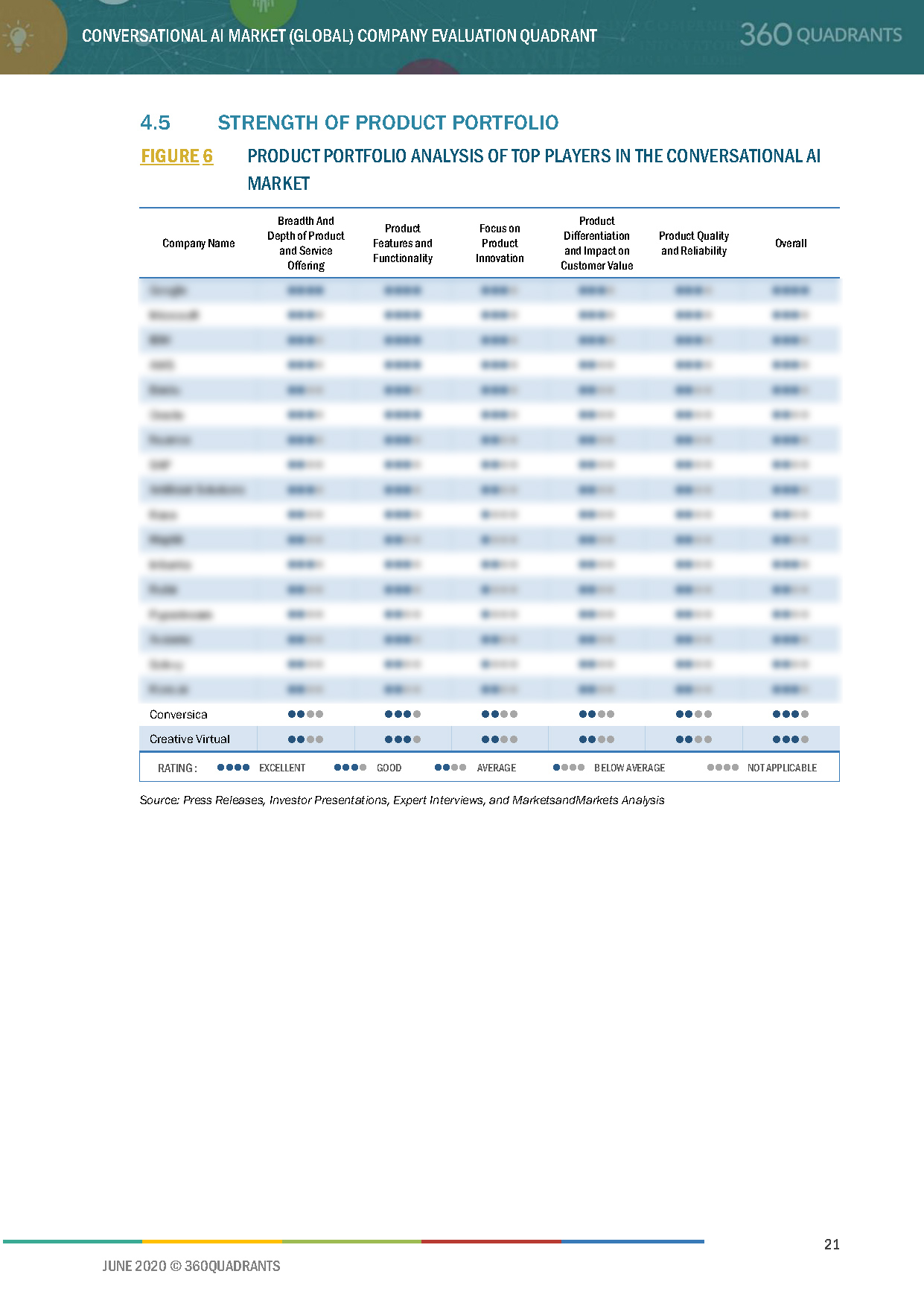
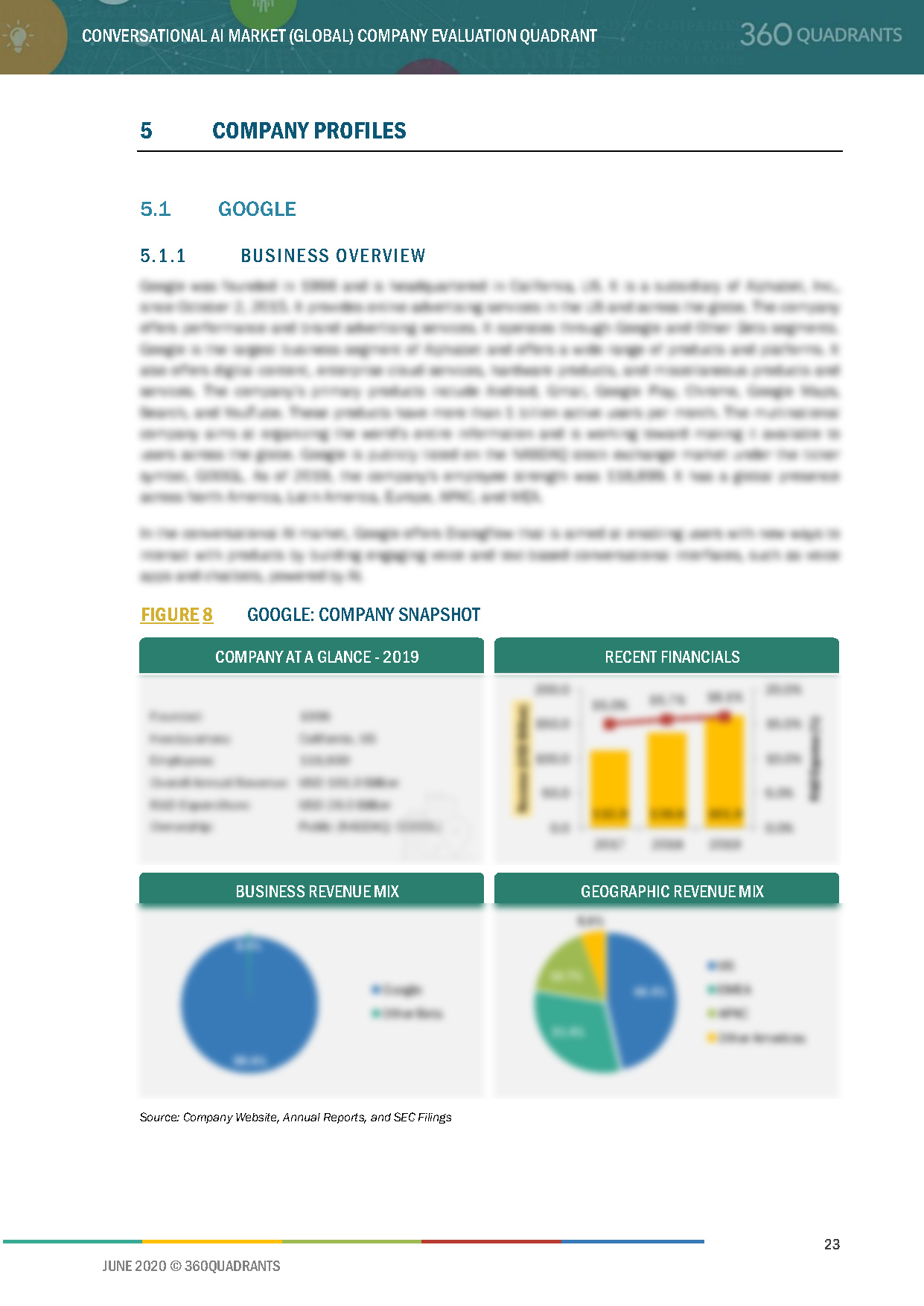
- Updated version of this Quadrant
- Different Company Evaluation Quadrant
- 'Startup Only' Company Evaluation Quadrant
- Region or Country specific evaluation
- Application or Industry specific evaluation ..Read More
- Submit a Briefing Request
- Question about our published research
- Request for evaluation of your organization for specific market
- Request for re-evaluation of Company Evaluation Quadrant ..Read More
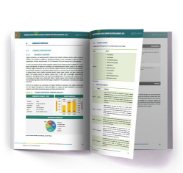 Conversational AI is a form of technology that utilizes speech-based assistants and facilitates stronger interactions and greater engagement at scale across users and platforms. Conversational AI combines speech-based technology, Natural Language Processing (NLP), and Machine Learning (ML) into a single platform to develop and build applications for any specific, as well as for multiple use-cases across verticals.
Conversational AI is a form of technology that utilizes speech-based assistants and facilitates stronger interactions and greater engagement at scale across users and platforms. Conversational AI combines speech-based technology, Natural Language Processing (NLP), and Machine Learning (ML) into a single platform to develop and build applications for any specific, as well as for multiple use-cases across verticals.